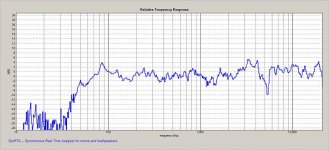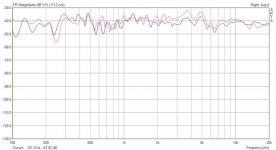Hello,
I've got a frequency dip and need some suggestions.
I've built a Folded ML TQWTL based on Bob Brines proposal. http://www.geocities.com/rbrines1/Pages/Proposals.html
Everything has been glued together with the exception of one side so I can experiment with stuffing. It's clamped together pretty tight at the moment. I included a BSC 5mH, 8 ohms (from solen), and no zobel. I think that the higher frequencies are cut out a bit for my tastes with the zobel. I'm using a 3" port, variable from 1" to 4" which I'm experimenting with.
The speakers sound awesome and has more than 100 hours of use. The BSC made the biggest difference for me.
I tested the speaker using a diy microphone as described by linkwitz. http://www.linkwitzlab.com/sys_test.htm. I built the preamp circuit for the mic verbatim, along with the panasonic mic mod, although I used a LM49710 opamp instead of the OPA2132 (for low noise). The preamp is powered by two 9V batteries.
I used SynRTA software to do the measurements using an m-audio transit USB audio interface.
From the near field measurements collected, there seems to be a few dips. Near 1kHz and more noticeably between 5-6kHz.
I don't understand where this is coming from. Would it be due to stuffing? or something else. Also, should this speaker drop off as shown in the graph?
Any suggestions would be great.
I've got a frequency dip and need some suggestions.
I've built a Folded ML TQWTL based on Bob Brines proposal. http://www.geocities.com/rbrines1/Pages/Proposals.html
Everything has been glued together with the exception of one side so I can experiment with stuffing. It's clamped together pretty tight at the moment. I included a BSC 5mH, 8 ohms (from solen), and no zobel. I think that the higher frequencies are cut out a bit for my tastes with the zobel. I'm using a 3" port, variable from 1" to 4" which I'm experimenting with.
The speakers sound awesome and has more than 100 hours of use. The BSC made the biggest difference for me.
I tested the speaker using a diy microphone as described by linkwitz. http://www.linkwitzlab.com/sys_test.htm. I built the preamp circuit for the mic verbatim, along with the panasonic mic mod, although I used a LM49710 opamp instead of the OPA2132 (for low noise). The preamp is powered by two 9V batteries.
I used SynRTA software to do the measurements using an m-audio transit USB audio interface.
From the near field measurements collected, there seems to be a few dips. Near 1kHz and more noticeably between 5-6kHz.
I don't understand where this is coming from. Would it be due to stuffing? or something else. Also, should this speaker drop off as shown in the graph?
Any suggestions would be great.
ljfont said:I don't understand where this is coming from. Would it be due to stuffing? or something else. Also, should this speaker drop off as shown in the graph?
It is not from the cabinet design or the stuffing, those only influence the lower bass frequencies. It is probably associated with the driver's response at high frequency or the measurement set-up.
Thank you for your response, and for your dedication to the diy community.
I got similar results with both left and right speakers, so now I will try the following with more measurements.
1. Build another mic capsule
2. Loopback tests with the m-audio device (bandwidth)
3. Maybe build another preamp, or use film caps in the circuit.
I will post more info after these tests.
Thanks.
I got similar results with both left and right speakers, so now I will try the following with more measurements.
1. Build another mic capsule
2. Loopback tests with the m-audio device (bandwidth)
3. Maybe build another preamp, or use film caps in the circuit.
I will post more info after these tests.
Thanks.
Have you tried measuring a completely different speaker to see if the response shows the same trend? That might help determine if it is your measurement set-up or just a property of the Fostex driver.
Your plot does not look too bad. Try some measurements at different distances, maybe at 1 m. Then do an in room measurement with the speaker placed in the final position and the mic at the listening position. I think you will find that the in-room measurement looks really bad, peaks and dips and a general ragged response, but in the end the speaker sounds much better then the plot would indicate. That is reality.
Your plot does not look too bad. Try some measurements at different distances, maybe at 1 m. Then do an in room measurement with the speaker placed in the final position and the mic at the listening position. I think you will find that the in-room measurement looks really bad, peaks and dips and a general ragged response, but in the end the speaker sounds much better then the plot would indicate. That is reality.
Yes, I measured another speaker with very different results (near field) so, perhaps those are the properties of the fostex drivers. I read a post somewhere by Bob Brines, and he says that the 1kHz bump is part of the driver. However, his graph on his latest designs do not show a bump around 5-6kHz. So I'm just wondering what that is.
I will try the other measurements as you suggest.
Thanks.
I will try the other measurements as you suggest.
Thanks.
FWIW, if after all the measurements (and a few hundred hours of listening) , the "speakers sound awesome", perhaps there's nothing left to "fix"?
No doubt you could expend a lot of time and employ any number of techniques (including careful gating and smoothing) to "fine tune" the system to achieve great looking measurements. I think however, in the process there's the risk of losing some degree of the musical excitement and intimacy that can be the hallmark of any full range speaker.
No doubt you could expend a lot of time and employ any number of techniques (including careful gating and smoothing) to "fine tune" the system to achieve great looking measurements. I think however, in the process there's the risk of losing some degree of the musical excitement and intimacy that can be the hallmark of any full range speaker.
ljfont, your measurement appears to be typical for a full range driver, particularly one with a whizzer. I'm not bad mouthing full range drivers in the least here. I understand their merits, as well as their drawbacks. Flat frequency response is often one of their disadvantages (among other things), especially with those of more than just a few inches in diameter. Of course, multi-way designs introduce a whole new array of problems (I'm well aware of that, too). I'm just saying. I don't think there's anything seriously wrong with your measurement setup. It sounds like Piek can provide you with some help, in regards to obtaining a flatter response from your drivers, likely by performing some slight modifications to the drivers themselves. There are plenty of people around here with a lot of experience in getting the most from all kinds of full range drivers, so no worries. Goodluck, and happy listening..
Piek said:the problems at 3,5Khz- 5,5kHz are driver inherent and need to be adressed. If you need help with that, send me a pm.
I'm sure we are all interested... That is a pretty flat curve, how did you achieve it?
dave
ljfont said:Graph.
Your curve is consistent with my curve made on a very large baffle
except the dip at 4 to 6 KHz, which I think is an artifact of your
baffle.
Thank you all for the information and suggestions. Well, there is more to think about now.
I think that maybe I'll try experimenting with baffles before any speaker mods.
1. Measure the speaker, without any baffles.
2. Build an open baffle just for test and measurement.
3. Add a supra baffle to this proposed design.
So my questions are:
1. What are the best materials for baffles? Is there a preference? MDF vs. Baltic Birch?
2. Does it effect the sound if the hole is "rounded" with a router?
3. Are there any formula's for calculating supra baffles? or just larger stiffer ones?
Thanks.
I think that maybe I'll try experimenting with baffles before any speaker mods.
1. Measure the speaker, without any baffles.
2. Build an open baffle just for test and measurement.
3. Add a supra baffle to this proposed design.
So my questions are:
1. What are the best materials for baffles? Is there a preference? MDF vs. Baltic Birch?
2. Does it effect the sound if the hole is "rounded" with a router?
3. Are there any formula's for calculating supra baffles? or just larger stiffer ones?
Thanks.
- Status
- This old topic is closed. If you want to reopen this topic, contact a moderator using the "Report Post" button.
- Home
- Loudspeakers
- Full Range
- Folded ML TQWTL Fostex FE167E Frequency Respose Questions...

